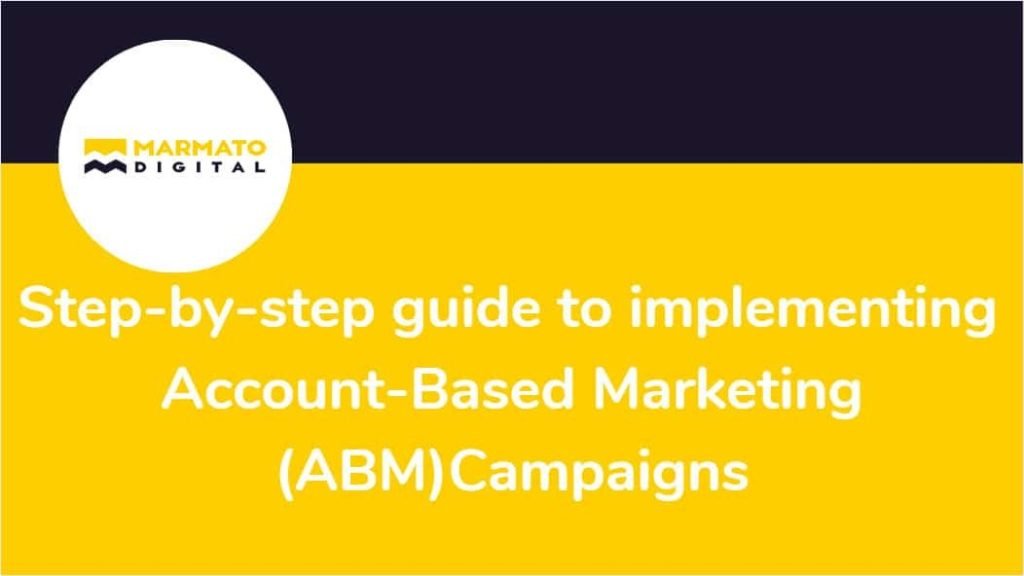Implementing Account-based Marketing (ABM) strategies in a campaign can be a highly effective approach for businesses aiming to engage and convert high-value target accounts. Unlike traditional marketing approaches that cast a wide net, account-based marketing campaigns focus on personalized and targeted outreach to key decision-makers. By aligning marketing and sales efforts, account-based marketing campaigns allow for tailored messaging and content that resonate with the unique needs and pain points of the target accounts.
Let’s explore the steps to implement account-based marketing campaigns for empowering businesses to drive deeper engagement, increase conversion rates, and foster long-term relationships with their most valuable accounts.

Steps to implement Account-Based Marketing (ABM) Campaigns:
Step 1 - Define campaign objectives:
Clearly outline your goals for the ABM campaign.
Are you aiming to generate leads, nurture existing accounts, or drive revenue from specific target accounts?
Clearly articulate your goals to align your efforts and measure success. Setting clear goals will help you develop a focused and effective campaign strategy.
Step 2 - Identify target accounts:
Determine the specific market segment you want to target with your ABM efforts. Research and identify high-value accounts within your target market that align with your campaign objectives.
Consider factors such as revenue potential, industry fit, and strategic value. Use data sources, market research, and insights from your sales team to compile a list of target accounts.
Step 3 - Build account profiles:
Create detailed profiles for each target account, including key decision-makers, pain points, business challenges, and goals. Leverage both internal data and external sources to gather insights and build a comprehensive understanding of each account.
Step 4 - Craft personalized messaging and content:
Craft personalized messages and content that resonate with the target accounts. Specifically, tailor you’re messaging to address their pain points and highlight how your products or services can provide solutions.
Use a mix of digital content formats such as emails, social media posts, blogs, videos, whitepapers, webinars, and case studies. Additionally, develop personalized website experiences, landing pages, emails, and ads that speak directly to the challenges and goals of the account. Finally, employ dynamic content and personalization techniques to enhance relevance.
Step 5 - Implement targeted advertising:
Utilize digital advertising platforms to target your specific accounts. In addition, use account-based targeting options on platforms like Google Ads, LinkedIn Ads, or Facebook Ads. Next, create tailored ad campaigns that address the challenges and goals of each target account, increasing relevancy and engagement.
Step 6 - Determine the best channels:
Identify the most effective channels to reach decision-makers within your target accounts. This may include email campaigns, social media, industry events, direct mail, or targeted advertising. Research the preferred communication channels of your target accounts and ensure your message reaches them effectively.
Step 7 - Leverage social media:
Engage with decision-makers from your target accounts on social media platforms. Follow and connect with them on LinkedIn, Twitter, and other relevant platforms. Share valuable content, comment on their posts, and participate in industry discussions to establish relationships and build awareness.
Step 8 - Create account-specific landing pages:
Develop landing pages tailored to each target account. These landing pages should align with the specific pain points and goals of the account. Customize the messaging, visuals, and calls to action to resonate with the decision-makers within the account and drive conversions.
Step 9 - Use personalized email campaigns:
Implement personalized email campaigns for each target account. Craft emails that address their unique challenges and goals and highlight how your offerings can solve their problems. Leverage automation tools to personalize the content based on account-specific data and triggers.
Step 10 - Measure and track results:
Establish relevant KPIs to track the effectiveness of your ABM campaigns. Implement tracking and analytics tools to measure the performance of your ABM campaigns. Monitor metrics such as engagement rates, click-through rates, conversion rates, and revenue generated from the target accounts. Analyze the data to evaluate the effectiveness of your campaigns and make data-driven optimizations.
Step 11 - Nurture and follow-up:
The success of ABM relies heavily on the collaboration between sales and marketing teams. Collaborate closely with the sales team to nurture and follow up with leads generated from your ABM campaigns. Provide them with insights and data on engagement and interactions with the target accounts. Work together to tailor personalized outreach and follow-up strategies to maximize conversion rates.
Step 12 - Leverage partnerships and referrals:
Consider leveraging partnerships or referrals from existing clients, industry influencers, or complementary businesses. These referrals can help establish credibility and increase the chances of engaging with your target accounts.
Step 13 - Iterate and optimize:
Continuously iterate and optimize your ABM campaigns based on the results and feedback obtained. Test different messaging, channels, and tactics to find the most effective combination for engaging your target accounts. Adapt your approach as you gather more insights and learn from the outcomes.
In conclusion, implementing an account-based marketing (ABM) strategy in digital marketing campaigns can be a game-changer for businesses looking to connect with their most valuable target accounts. By personalizing messages, leveraging targeted advertising, and utilizing digital channels effectively, companies can establish meaningful relationships with decision-makers and increase the likelihood of conversion.
ABM allows for a more focused and tailored approach, enabling businesses to address the unique pain points and goals of each account. Remember to continuously measure and optimize your campaigns based on data and feedback and maintain alignment between your marketing and sales teams. With a well-executed ABM strategy, businesses can unlock the full potential of their digital marketing campaigns and drive remarkable results.
Embrace the Power of Account-Based Marketing (ABM) Today!
Take the leap and experience the transformative power of Account-Based Marketing for your business! With ABM, target high-value accounts, personalize your marketing efforts, and build a strong relationship. Discover the secrets to unlocking unparalleled success and start your ABM journey today.
Partner with Marmato Digital and harness the power of ABM for your business success. Let us guide you through the world of ABM, from identifying ideal target accounts to crafting personalized content and engaging multi-channel campaigns. Contact Us today to revolutionize your marketing and achieve remarkable results!
Subscribe to blogs
Get our latest blogs directly to your inbox.

